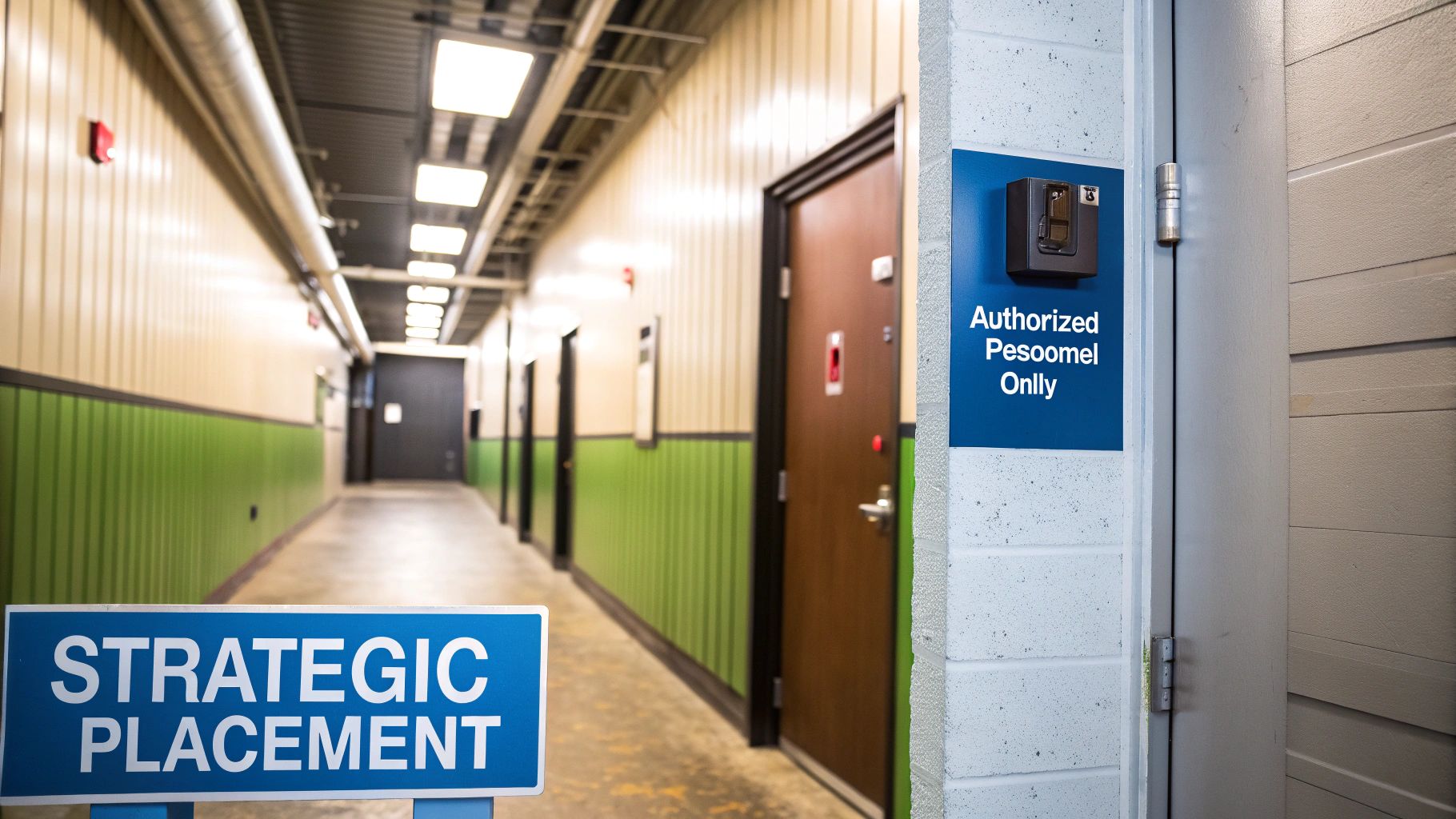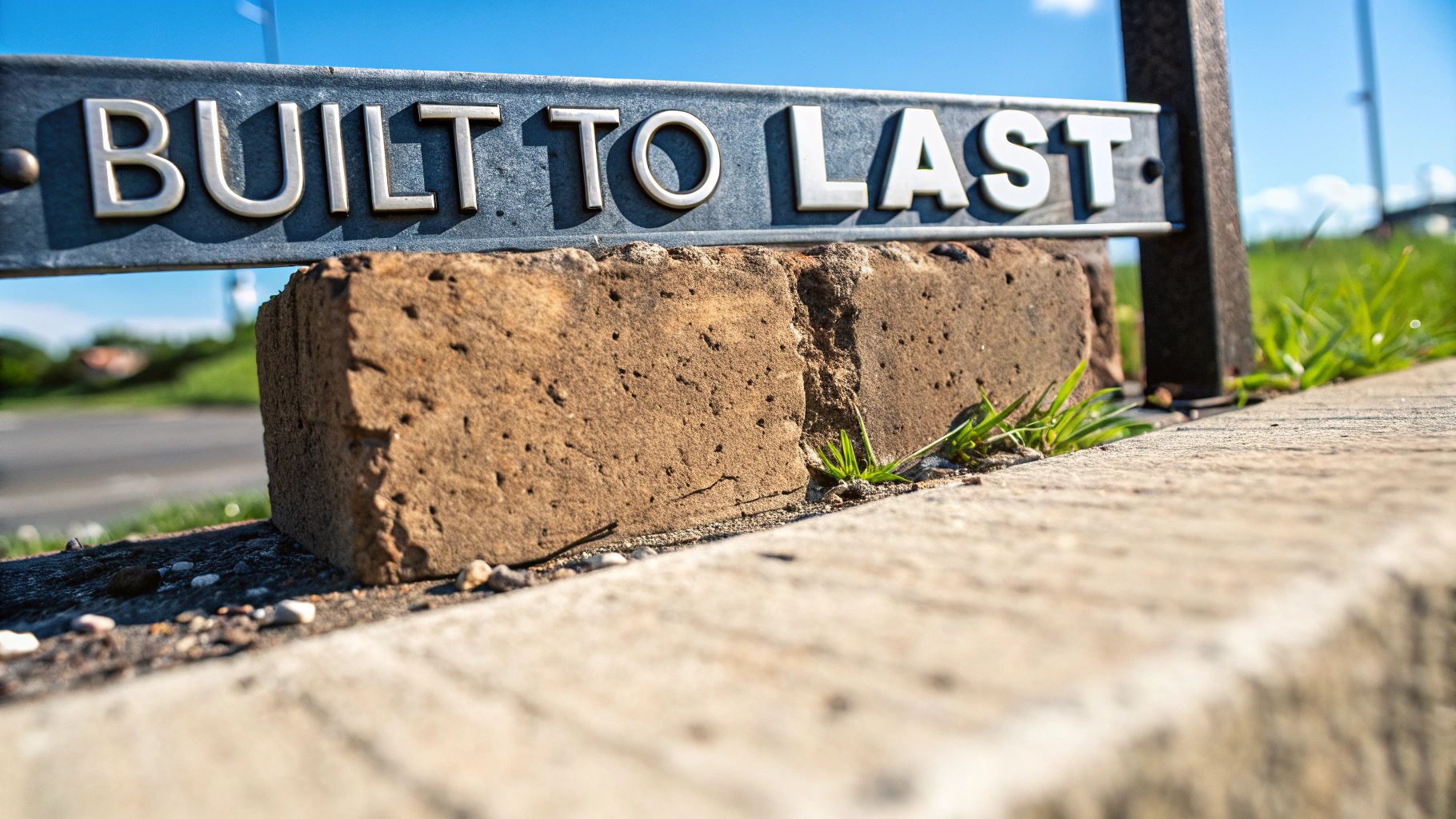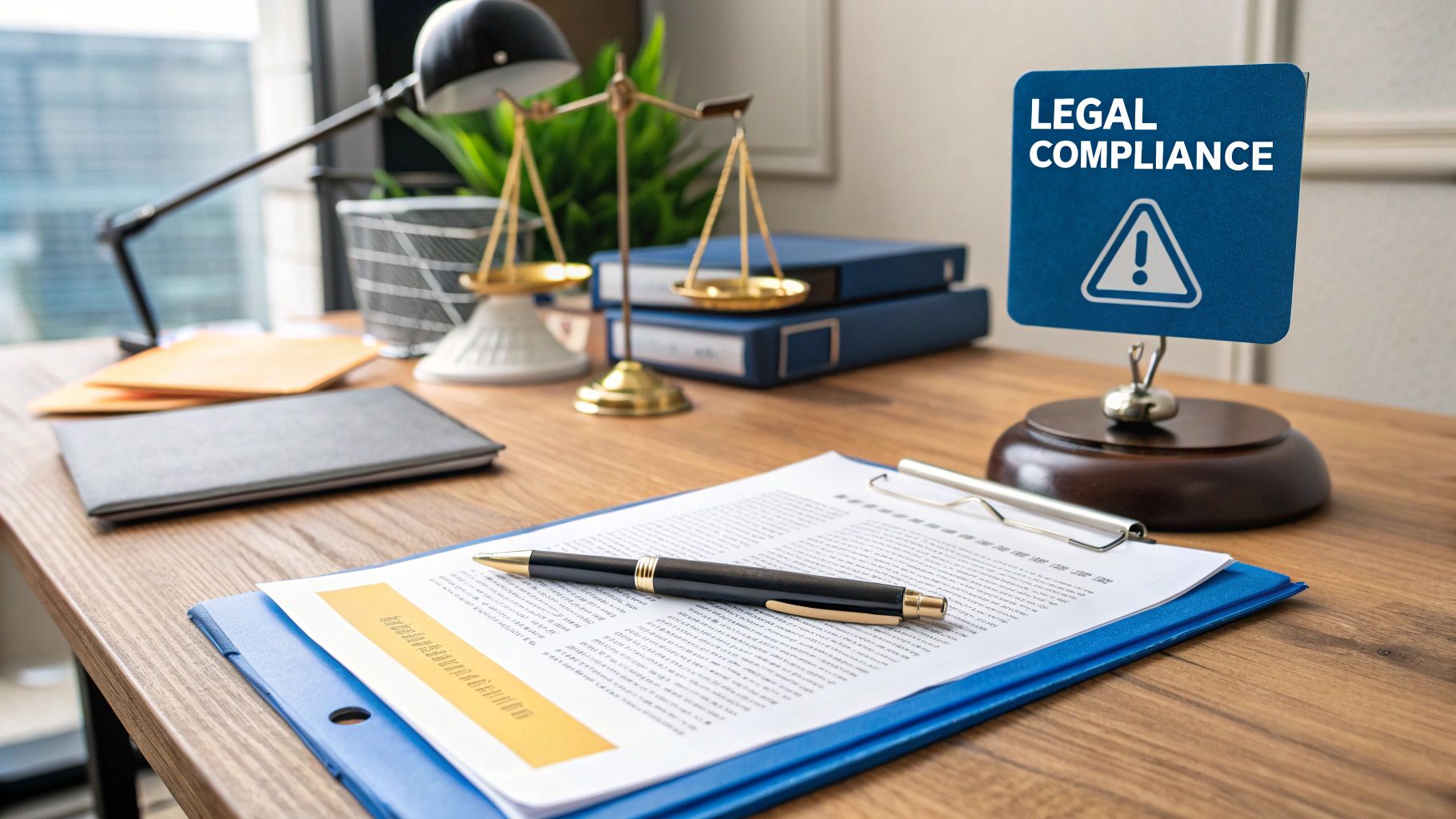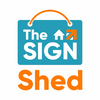An 'Authorised Personnel Only' sign isn't just a suggestion; it's a direct, no-nonsense instruction that fences off certain areas of your workplace. Think of these signs as a fundamental tool in your health and safety kit, clearly flagging up zones that could be dangerous for untrained people or that house sensitive equipment and information. They are, without a doubt, your first line of defence in preventing accidents and keeping you on the right side of the law.
Why These Signs Are a Critical Safety Layer
Imagine an 'Authorised Personnel Only' sign as a physical firewall for your business. A digital firewall stops unauthorised traffic getting to your sensitive data, right? Well, these signs do exactly the same thing in the real world, blocking untrained staff or visitors from wandering into places where they could get hurt or cause serious problems.
This simple piece of visual communication is a cornerstone of a proactive safety culture. It’s about more than just ticking boxes for compliance; it's about actively stopping incidents before they even have a chance to happen.
Without that clear warning, it's all too easy for an employee, visitor, or contractor to unknowingly stroll into a hazardous area. We're talking about places with dangerous machinery, chemical storage, high-voltage electrical panels, or even secure data centres. The fallout from a simple mistake like that can range from a life-changing injury to a major security breach – all of which are entirely preventable.
The Role in HSE Compliance
Here in the UK, the Health and Safety Executive (HSE) is crystal clear about an employer's duty of care. A huge part of that duty is carrying out proper risk assessments and putting controls in place. An 'Authorised Personnel Only' sign is the tangible, visible proof that you've done just that. It shows that you have:
- Identified a Hazard: You've spotted an area that poses a specific risk.
- Assessed the Risk: You've figured out that the best way to manage that risk is to limit who can go there.
- Implemented a Control: The sign itself is the control measure, telling everyone about the restriction.
When you clearly mark a restricted zone, you’re doing more than just putting up a sign. You are actively managing risk in a way the HSE expects. This simple act helps you build a legally defensible 'safe system of work', which is vital for protecting both your people and your business from liability.
At the end of the day, it all boils down to control. These signs make sure that only the people with the right training, know-how, and Personal Protective Equipment (PPE) can get into high-risk spots. This controlled access is essential for protecting people, safeguarding valuable assets, and keeping your entire operation running smoothly and safely.
Navigating UK Legal Requirements for Access Control
Getting to grips with the legal side of access control is non-negotiable for any UK business. It’s what turns an ‘Authorised Personnel Only’ sign from a polite suggestion into a legally sound instruction, all tied into an employer's fundamental duty of care. This isn't just red tape; it's about building a safe, legally defensible workplace, just as UK law demands.

The big player here is the Health and Safety at Work etc. Act 1974. It's the bedrock legislation that gives employers a clear, firm responsibility to look after the health, safety, and welfare of their team, as far as is reasonably practicable.
This isn't a sit-back-and-wait kind of duty. It demands you get on the front foot, spotting risks and shutting them down. And that’s exactly where a smart access control strategy, clearly marked with the right signs, becomes a direct, visible way you’re meeting your legal duties.
The Role of Risk Assessments
Digging a bit deeper, we have the Management of Health and Safety at Work Regulations 1999. These get more specific, requiring every employer to carry out a "suitable and sufficient" risk assessment.
An ‘Authorised Personnel Only’ sign is a direct result of this process. When you’ve identified an area with hazardous machinery, dangerous chemicals, or high-voltage gear, your assessment will almost certainly conclude that you need to limit who goes in there. That sign is the simplest, most effective way to communicate and enforce that control.
Think of it as a firewall for your physical premises. A digital firewall scans incoming traffic and blocks anything dodgy from getting through and wrecking your network. In the same way, these signs act as a gatekeeper, stopping unauthorised 'access' that could lead to serious accidents, data theft, or damaged equipment.
A correctly placed 'Authorised Personnel Only' sign is more than a deterrent; it is a clear statement of your risk assessment's findings. It demonstrates you have identified a hazard and implemented a practical control, which is a cornerstone of building a safe system of work recognised under UK law.
Why Compliance Goes Beyond Avoiding Fines
Sticking to these rules isn't just about dodging fines from the Health and Safety Executive (HSE). It’s about fostering a robust safety culture that protects absolutely everyone on site, from your seasoned employees to visitors and contractors who don't know the lay of the land.
The HSE is laser-focused on making sure employers are restricting access to dangerous zones. In fact, HSE statistics for 2022/23 show that contact with machinery and being struck by a moving object were among the most common causes of non-fatal workplace injuries. This highlights just how vital clear warnings are. What’s more, research has found that putting up clear, distinct signage can slash these unauthorised entry incidents by up to 40%. That’s a massive win for safety and a clear signal that you’re committed to a secure workplace.
Integrating Signage with a Broader Strategy
But let's be realistic—a sign on its own isn't a fortress. The most effective access control is a layered defence, where visual warnings work hand-in-hand with other security measures to create a truly secure environment.
For instance, while 'authorised personnel only' signs are great visual cues, they're at their best when paired with solid apartment building access control systems or other commercial security hardware. This gives you a powerful one-two punch of visual deterrents and physical barriers.
A proper layered approach could involve:
- Physical Barriers: Using locked doors, security gates, or keycard entry systems to physically stop people.
- Procedural Controls: Having clear company policies that spell out who can go where and why.
- Training: Making sure every single member of staff understands what the signs mean and the serious consequences of ignoring them.
When you weave these elements together, you're moving beyond basic box-ticking and creating a genuinely secure, well-managed space. Ultimately, these signs are a vital, legally-backed tool for managing risk and upholding your duty of care.
Designing Signs for Maximum Impact and Compliance
For an 'Authorised Personnel Only' sign to actually work, it needs to do more than just hang on a wall. It has to grab your attention, get its message across in a split second, and leave zero room for doubt. This is where smart design, guided by UK regulations, turns a simple warning into a powerful safety tool.

The rulebook we all have to follow is the Health and Safety (Safety Signs and Signals) Regulations 1996. This legislation is the reason safety signs look consistent across the UK. The whole point is to create a universal visual language that everyone can instantly recognise and understand, no matter where they work.
The Power of Colour and Symbols
Think about the most common 'do not enter' sign you've ever seen – a red circle with a line slashed through it. That design isn't a random choice. The 1996 Regulations set out specific colour codes that tap into our built-in psychological responses to get the message across fast.
An "Authorised Personnel Only" sign falls squarely into the prohibition category. The key ingredients are:
- A Round Shape: This is the standard format for telling someone not to do something.
- A Red Border and Crossbar: Red screams danger, stop, or prohibition. It's a universal trigger for caution.
- A White Background: This creates a high-contrast backdrop, making the other elements pop.
- A Black Pictogram: A simple symbol, like the outline of a person, sits behind the red crossbar, clearly showing the action that’s forbidden.
This specific mix of shape, colour, and symbol communicates "Do Not Enter" far more quickly and effectively than words ever could on their own. It’s an instant visual command.
Typography and Text Clarity
While the symbol does the heavy lifting, the text adds the crucial context. The phrase "Authorised Personnel Only" must be clear, direct, and easy to read from a safe distance. The regulations don't force a particular font on you, but best practice points towards clean, sans-serif typefaces like Helvetica or Arial.
The golden rule here is legibility. If the text isn't large enough or doesn't have enough contrast to be easily read in its intended location, the sign is useless. Poor typography can completely undermine an otherwise compliant sign.
The lettering should always be bold and simple. Steer clear of any decorative or script fonts that could be misread, especially in a panic or in low-light conditions.
Getting the Size and Contrast Right
Choosing the right size for your authorised personnel only signs isn't a guessing game; it’s all about visibility. A sign that’s too small for its surroundings is a failed safety measure. You have to think about the typical viewing distance – how far away will someone be when they need to see and understand the warning?
For a massive space like a warehouse or an outdoor construction site, a larger sign with bold, high-contrast elements is non-negotiable. For a small storeroom door, however, a more modest size will do the job just fine.
The key is making sure the prohibition symbol and text are instantly recognisable from any direction someone might approach the restricted area. That punchy contrast between the red, white, and black elements is what makes the sign stand out, ensuring its message cuts through any visual clutter and is obeyed without a second thought.
Choosing the Right Sign Material for Your Environment
A sign's message is only as good as its ability to be seen. Choosing the right material for your ‘Authorised Personnel Only’ signs is every bit as crucial as the design itself, especially when you’re up against the unpredictable British weather or the demanding conditions inside a factory. It’s all about matching the material to the environment to make sure your sign lasts, stays compliant, and does its job day in, day out.

Think of it like picking the right coat. You wouldn’t wear a thin jacket in a downpour, would you? It’s the same logic for signs. The material has to be tough enough for its specific location, whether that's a rain-lashed exterior wall, a bustling factory floor, or a sterile lab.
Durable Metals for Outdoor and Industrial Use
When your sign needs to stand its ground against the elements, tough metals like aluminium are the go-to choice. Aluminium is naturally rust-proof and weathers the storm beautifully, making it perfect for outdoor spots on fences, gates, and exterior walls where it’ll face rain, wind, and sun.
This resilience is precisely why aluminium signs make up a significant portion of the UK market for restricted area signage. They ensure the warning stays crisp and clear for years, preventing the message from fading into oblivion. For even harsher environments, like chemical plants or coastal areas with salty sea air, stainless steel is another fantastic option, offering superior strength and corrosion resistance. If you want to dig deeper, you can explore the different types of safety signs available in the UK.
Comparison of Common Sign Materials
To help you decide, we've put together a quick comparison of the most common materials. This table breaks down their best uses and key features, making it easier to select the perfect option for your workplace.
| Material | Best Use Case | Durability | Weather Resistance | Cost |
|---|---|---|---|---|
| Aluminium | Outdoors, industrial sites, fences | High | Excellent | Moderate |
| Stainless Steel | Harsh chemical or coastal areas | Very High | Superior | High |
| Rigid PVC Plastic | Indoors, offices, warehouses | Good | Low | Low |
| Self-Adhesive Vinyl | Smooth surfaces, doors, windows | Moderate | Low | Very Low |
Ultimately, the best material depends entirely on where the sign will live. A little thought now saves you the headache and cost of replacing a worn-out sign later.
Versatile Plastics for Indoor Environments
For indoor areas, you can't go wrong with rigid PVC plastic. It's tough, lightweight, and has a smooth, professional finish that’s a doddle to clean. This makes it a brilliant all-rounder for all sorts of settings, from office corridors to warehouse interiors.
Just picture it in these scenarios:
- Factory Floors: Rigid plastic can take the odd knock from a passing trolley or piece of equipment without fuss.
- Hospitals and Kitchens: Its non-porous surface is easy to wipe down, which is essential for maintaining strict hygiene standards.
- Retail Stockrooms: It provides a clear, cost-effective warning that’s more than durable enough for the daily grind.
The real beauty of rigid plastic is its perfect balance of durability and affordability for indoor use. You get a professional, long-lasting sign without the higher price tag of metal.
Flexible Vinyl for Smooth Surfaces
Sometimes you just need a quick and easy solution. That's where self-adhesive vinyl signs come in. Think of them as durable, industrial-strength stickers that you can apply directly to smooth, clean surfaces like doors, windows, and machinery without any need for drills or fixings.
Their flexibility is a huge plus in places where permanent fixtures are a no-go. For instance, a vinyl 'Authorised Personnel Only' sign is perfect for a server room door or a laboratory cabinet. It delivers a clear warning that’s simple to apply and just as easy to clean, letting you place a warning exactly where it's needed most.
Strategic Placement for Unmistakable Warnings
So, you’ve got the perfect sign. But a great sign in the wrong place is about as useful as a chocolate teapot. Strategic placement is what turns your ‘Authorised Personnel Only’ signs from a polite suggestion into an unmissable command, actively preventing people from wandering where they shouldn’t. Getting this right isn’t just good practice; it's a fundamental part of your duty of care under UK health and safety law.

The core idea is brilliantly simple: a person must see and understand the sign before they can enter the restricted zone. Think of it like a stop sign at a junction – it’s placed well before the white line, giving you plenty of time to see it, process it, and hit the brakes. Your safety signs need that same common-sense logic to work properly.
The Eye-Level Imperative
If you remember one rule, make it this one: always mount your signs at eye level.
For most people, this means the centre of the sign should be somewhere between 1.5 and 1.7 metres (that’s roughly 5 to 5.5 feet) from the ground. This height puts the sign squarely in a person's natural line of sight as they walk towards a door, making it nearly impossible to ignore.
Stick a sign too high or too low, and you’re forcing people to go looking for it. That defeats the whole point of an immediate warning. Placing it at eye level on every single potential entry point—whether it's a door, a gate, or an archway—creates a consistent, reliable visual barrier that people instinctively register.
Go on Patrol: Conduct a Site Walk-Through
To make sure you've covered all your bases, you need to think like someone trying to get in. The single best way to do this is a proper site walk-through. Grab a floor plan, put on your walking shoes, and physically trace the perimeter of your restricted areas. Your mission is to find every possible access route and potential blind spot.
As you walk, ask yourself these crucial questions:
- Is every single door and gate covered? Don't forget the less obvious ones like fire exits, service entrances, and loading bay doors.
- Are there any unconventional ways in? Think about ground-floor windows, service hatches, or even temporary gaps in fencing on a building site.
- Can the sign be seen from all angles? A sign mounted flat against a wall might be totally invisible to someone approaching from a side corridor.
- Is the area well-lit? A sign lurking in a gloomy corner might as well not be there. Make sure the lighting is up to scratch, or opt for reflective sign materials to ensure visibility.
Your objective is to leave no room for doubt. If there's a way in, a sign must be there to guard it. This hands-on approach is exactly what the Health and Safety Executive (HSE) expects, as it proves you’ve taken all "reasonably practicable" steps to control access to known hazards.
Real-World Scenarios for Nailing Placement
Let’s see how these principles play out in a few common workplace settings.
Example 1: The Busy Factory Floor
Imagine a large manufacturing area with several entrances. The main double doors are clearly signed, but a small side door used only for maintenance has been overlooked. A quick walk-through reveals the gap. The fix is simple: a tough PVC sign is installed at eye level on the maintenance door, instantly closing that safety loophole.
Example 2: The High-Security Lab Entrance
A laboratory handling hazardous materials has a keycard-only door. While the tech restricts physical entry, a clear sign stating "Authorised Personnel Only – Biohazard Risk" is mounted right next to it. This does two jobs: it reinforces the rule and clearly communicates the specific danger to anyone who might try to tailgate an employee inside.
Example 3: The Outdoor Electrical Substation
An electrical substation is secured by a chain-link fence. Instead of just putting one sign on the main gate, large, weatherproof aluminium signs are fixed directly to the fence itself at regular intervals. This means no matter which part of the perimeter someone approaches, the warning is right there in front of them, clear and unavoidable.
By thinking through these kinds of scenarios and carrying out a thorough site assessment, you can be confident your signs aren't just ticking a box—they're strategically positioned to actively protect your people and your property.
Integrating Signs into a Complete Safety System
An ‘Authorised Personnel Only’ sign is a brilliant start, but on its own, it’s like a goalkeeper with no defenders. For that sign to truly do its job, it has to be part of a proper, multi-layered safety system. We’re talking about blending physical barriers, crystal-clear procedures, and solid training. This holistic approach is what turns a simple sign from a passive warning into an active player in keeping your workplace secure and compliant.
Think of it this way: the sign is your first line of communication, but it definitely needs backup. When you reinforce that visual message with physical controls, you create a much more formidable barrier to unauthorised access. This isn't about building a fortress; it's about creating sensible, layered defences that make doing the right thing the easiest option.
Beyond the Sign: Physical and Procedural Layers
Imagine your safety strategy has several layers of protection, like an onion. If one fails, another is right there to catch the mistake. Your authorised personnel only signs are the visible outer layer, but they need to be supported by more tangible measures.
Consider integrating your signage with these key elements:
- Physical Barriers: A simple locked door is often enough. But you can also step it up with key card systems, coded entry pads, or even perimeter fencing to physically block entry where needed.
- Procedural Controls: Your company's health and safety policy is the rulebook. It must spell out exactly which areas are restricted, who is authorised to enter them, and the reasons why. This document is a critical piece of your legal compliance puzzle.
- Surveillance Systems: Let's be honest, CCTV cameras work. They act as a powerful deterrent and create a record of any unauthorised access attempts, hammering home the seriousness of the restriction.
When these elements work together, the sign’s warning is backed up by real-world consequences and physical prevention.
The Human Element: Comprehensive Employee Training
You can have all the signs and locks in the world, but arguably the most critical layer of your safety system is your people. A sign is completely useless if employees don’t understand or respect what it means. This is where comprehensive training, mandated by the Health and Safety at Work etc. Act 1974, is absolutely essential.
Effective training has to go beyond just telling staff, "Don't go in there." It needs to dig into the "why" behind the rule.
Employees who understand the specific hazards—whether it’s high-voltage equipment, dangerous chemicals, or sensitive data—are far more likely to follow the rules. Training transforms a simple instruction into a shared responsibility for everyone's safety.
Your training programme should hammer home the basics. Every single staff member, from the newest hire to the most senior manager, must be able to answer these questions without hesitation:
- What does an ‘Authorised Personnel Only’ sign actually mean in our workplace?
- Which specific areas are off-limits to me and why?
- What are the real-world consequences of entering a restricted zone without authorisation?
- What is the correct procedure if I need to access a restricted area for a legitimate reason?
Folding these signs into a broader workplace safety plan is a cornerstone of good risk management. For businesses looking to formalise their procedures, a comprehensive OSHA Emergency Action Plan template can provide a really useful framework—even for UK companies—by outlining clear roles and procedures. At the end of the day, understanding the importance of signs means recognising them as vital communication tools within a living, breathing safety culture.
Got Questions? We’ve Got Answers.
When it comes to authorised personnel only signs, a few common questions always pop up. It’s one thing to know you need them, but another to get the details right. Let's clear up the confusion so you can make sure your workplace is safe, secure, and playing by the rules.
What's the Law on These Signs in the UK?
The big one you need to know is the Health and Safety (Safety Signs and Signals) Regulations 1996. This isn't just a dusty old document; it's the rulebook that dictates exactly how safety signs should look and function.
It sets out the specific colours, shapes, and symbols for prohibition signs. This creates a universal language that everyone, from a factory floor worker to a lab technician, can understand in a split second. Following these rules isn't optional—it's a legal must-have for clear, effective safety.
Can I Just Make My Own Custom Sign?
You can, but with a big caveat: any custom sign must stick to the design rules from the 1996 Regulations. For a prohibition sign like "Authorised Personnel Only," that means no creative freelancing on the core elements. It absolutely has to have:
- A round shape (the universal symbol for "don't").
- A bold red border and a red crossbar.
- A clean white background for maximum contrast.
- A black pictogram showing what's forbidden.
Feel free to add text for more detail, like explaining why the area is restricted, but those four design pillars are non-negotiable if you want to stay compliant.
The whole point of these regulations is instant recognition. A sign that looks different could cause a moment of hesitation or confusion, and that’s all it takes for an accident to happen. It could also mean you're failing to meet your legal duties under the broader Health and Safety at Work etc. Act 1974.
Where’s the Best Place to Put the Sign?
Placement is everything. A sign is useless if it's seen too late. It needs to be positioned so that anyone approaching the area can see it, read it, and understand it before they have a chance to step into the restricted zone.
The golden rule is to mount it at eye level, which is generally somewhere between 1.5 and 1.7 metres from the ground. And don't just put one on the main door—place a sign at every single point of entry. Think service doors, side gates, or any other way someone might access the area. You want to make the warning impossible to miss.
Are Signs Really Enough on Their Own?
In a word, no. While signs are a critical first line of defence, they work best as part of a complete safety system. They’re the visual cue, the clear warning shot.
Think of it like layers of security. The sign tells people the rule, but a locked door or a keycard system physically enforces it. The final, and arguably most important, layer is training. When your team understands why an area is restricted, they become active participants in keeping everyone safe. It turns a simple rule into a shared responsibility.
Ready to secure your workplace with clear, compliant signage? At The Sign Shed, we offer a huge range of high-quality, HSE-compliant "Authorised Personnel Only" signs to suit any environment. Explore our collection and ensure your safety systems are up to standard. Visit https://www.thesignshed.co.uk to find the perfect solution today.
Article created using Outrank


0 comments